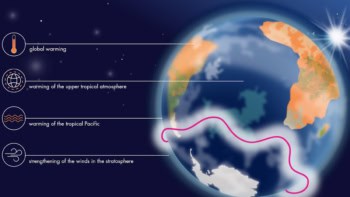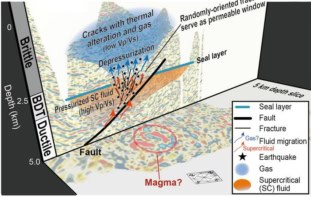Although there is little doubt that the Earth's climate has become warmer over the twentieth century, there is still an ongoing debate about whether the temperature increase is due to natural variations or to human activity. Two groups of UK scientists have recently investigated both types of effect. Mike Lockwood and colleagues at the Rutherford Appleton Laboratory (RAL) argue that the Sun's magnetic field has doubled over the century, and that this natural "solar forcing" will have affected the earth's climate (Nature 399 437). Meanwhile Simon Tett and colleagues from the UK's Meteorological Office in Reading and RAL argue that while solar forcing may have contributed to climate change early in the century, humanity activities have been responsible for the temperature changes over the past 50 years (Nature 399 569).
The Earth’s average global temperature has increased by 0.6 Kelvin in the past 100 years. There are believed to be four main processes that can effect the Earth’s climate. Two of these, small aerosol particles from volcanic eruptions and changes in solar luminosity, occur naturally. The other two, sulphate aerosols and greenhouse gases such as carbon dioxide, are due to increasing industrialization, in particular the burning of forests and fossil fuels.
Lockwood and colleagues found that the total magnetic flux leaving the Sun has risen by a factor of 1.4 since 1964, and has probably increased by a factor of 2.3 since 1901. Their results could provide support for the theory that changes in the solar wind – a stream of charged particles emitted by the Sun – could contribute to climate change. The solar wind and the Sun’s magnetic field are intimately linked. According to the theory charged particles in the solar wind would deflect high-energy cosmic rays that would otherwise have ionized the Earth’s lower atmosphere, leading to the formation of clouds. Since cloud cover determines the amount of solar radiation reflected by the Earth back into space, a more powerful solar wind implies less cloud cover which, in turn, suggests that the Earth would warm up.
However, the paper by Tett and colleagues suggests that natural effects alone cannot account for the pattern of temperature change observed over the past 50 years. They used the HadCM2 computer model to predict the Earth’s global temperature during five overlapping 50-year periods (1906-56, 1916-1966, .), and then compared the results with observations. The program models both the oceans and the atmosphere, and also allows for changes in greenhouse emissions, surface albedo (i.e. reflectivity), volcanic aerosols and solar irradiance. They ran the programme with a number of different solar models, including one that matched the effects highlighted by Lockwood. The results were similar for all cases: it is not possible to distinguish between the contributions of human activity and natural variations to global warming in the first half of the century, but after 1946 increases in the concentration of man-made greenhouse gases and sulphate aerosols was the dominant effect.



